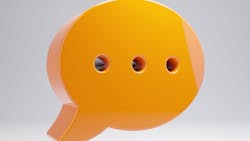Ask Dianne: How dental hygienists can respond to negative patient remarks
Dear Dianne,
I have been an RDH for more than two decades. I’ve just began a new job after leaving a job of 12 years when the doctor retired. The patients at the new practice are really nice. No one complains to me, but four patients have told the office manager that I’m rough. I discuss oral health thoroughly with every patient, whether he or she has gingivitis or gum disease. I explain why it hurts more here or there. I’m beside myself that they’ve complained. In all my years of practice, I have never had complaints like this. I do not know the previous hygienist, but I have noticed that many patients have radiographic calculus. It appears that she didn’t get deep enough to remove the calculus, but who am I to judge? I’m just frustrated about being compared to her. Can patients expect a painless cleaning?
—RDH Feeling Sad
Dear Feeling Sad,
Let’s talk about your dilemma from two perspectives, your patients’ and yours. Let’s start with your patients’ perspective. Evidently, your patients were accustomed to seeing a hygienist who was gentle with her technique. I call this the “tiptoeing-through-the-tulips” technique. Because you have observed radiographic calculus on a rather frequent basis, I assume that some subgingival calculus was not removed thoroughly. We don’t know why the former hygienist was not removing the calculus thoroughly, but several reasons are possible, including using dull instruments, lack of sufficient time, incorrect clinical technique, deficits in calculus detection, or patient discomfort. It could be a combination of factors.
The reality is that your patients can’t tell if all the calculus has been removed or not. They tend to judge the quality of a dentist or hygienist’s work based on things they can see and how they feel during the appointment. If a patient was accustomed to a painless dental hygiene visit in the past but had a visit with you that was painful, he or she might perceive you as rough.
Should patients expect painless preventive appointments? In my opinion, if a patient does not have disease activity in the form of gingivitis or periodontitis, the preventive appointment should not be a painful experience. For disease-free patients, a painful prophy usually means the hygienist is using incorrect clinical technique. If a prophy is painful for a disease-free patient, the patient might label the hygienist as rough. So, if a patient with no disease is complaining, then maybe you are being rough.
What about patients who complain about rough treatment when you are merely trying to do your job well and remove deep calculus? The answer is in proper anesthetic use. We have all kinds of good anesthetics to help keep our patients comfortable while we do our jobs. I don’t know if you can administer local anesthetic in your state, but you could certainly use a topical in the sulcus to take the edge off of deep scaling. One of my favorites is Cetacaine (Cetylite; cetylite.com). It comes in a kit with syringes you can fill with the amount you need. This product will give your patient 35 to 60 minutes of good tissue anesthesia.
With all your years of experience, you are certainly not a novice. You sound like a very thorough hygienist. I also expect that you are more aggressive in your clinical style than the previous hygienist. If that means that you are more efficient and thorough in removing calculus, that’s good for your patients. But I guarantee you that the patients won’t see it that way. If they perceive you as rough, they won’t like you. When patients don’t like their provider, either dentist or hygienist, they are more likely to break or cancel appointments. Who needs that? I’ve even known dentists to fire hygienists after they had received multiple complaints from patients about their care being painful.
In my first job as a hygienist, numerous patients told me, “You didn’t hurt me like the last girl,” and some even thanked me. Evidently, the hygienist before me was very rough. One patient called her the “blood and guts” hygienist. No competent hygienist should ever generate that type of patient perception!
Dental hygienists develop varying levels of skill in calculus detection and removal. After all, we are not robots. Although I believe most hygienists try very hard to get all the calculus off, the truth is that every hygienist leaves calculus from time to time. Sometimes residual calculus is not even detectible with an explorer and will not show up on a radiograph.
It’s not pleasant to be compared to a previous staff member, but the fact is that patients do it all the time, whether they liked the previous hygienist or not. Since you know of the complaints against your care, I recommend that you start using more topical when you see something deep that you need to remove. Explain to the patient that you are going to use a little numbing liquid to take the edge off. Your patient will appreciate it.
View these patient comments as means to help you improve your technique. After all, none of us are perfect. And if I’m in your chair as the patient, you’d better not hurt me!
All the best,
Dianne
Dianne Glasscoe Watterson, MBA, RDH, is an award-winning author, speaker, and consultant. She has published hundreds of articles, numerous textbook chapters, and three books. Her new DVD on instrument sharpening is now available on her website at wattersonspeaks.com under the products tab. Visit her website for information about upcoming speaking engagements. She may be contacted at (336) 472-3515 or by email at [email protected].
Editor’s note: A version of this article previously appeared as a Thursday Troubleshooter on DentistryIQ in September 2018.
About the Author
Dianne Glasscoe Watterson, MBA, RDH
DIANNE GLASSCOE WATTERSON, MBA, RDH, is a consultant, speaker, and author. She helps good practices become better through practical analysis and teleconsulting. Visit her website at wattersonspeaks.com. For consulting or speaking inquiries, contact Watterson at [email protected] or call (336) 472-3515.
Updated June 30, 2020

